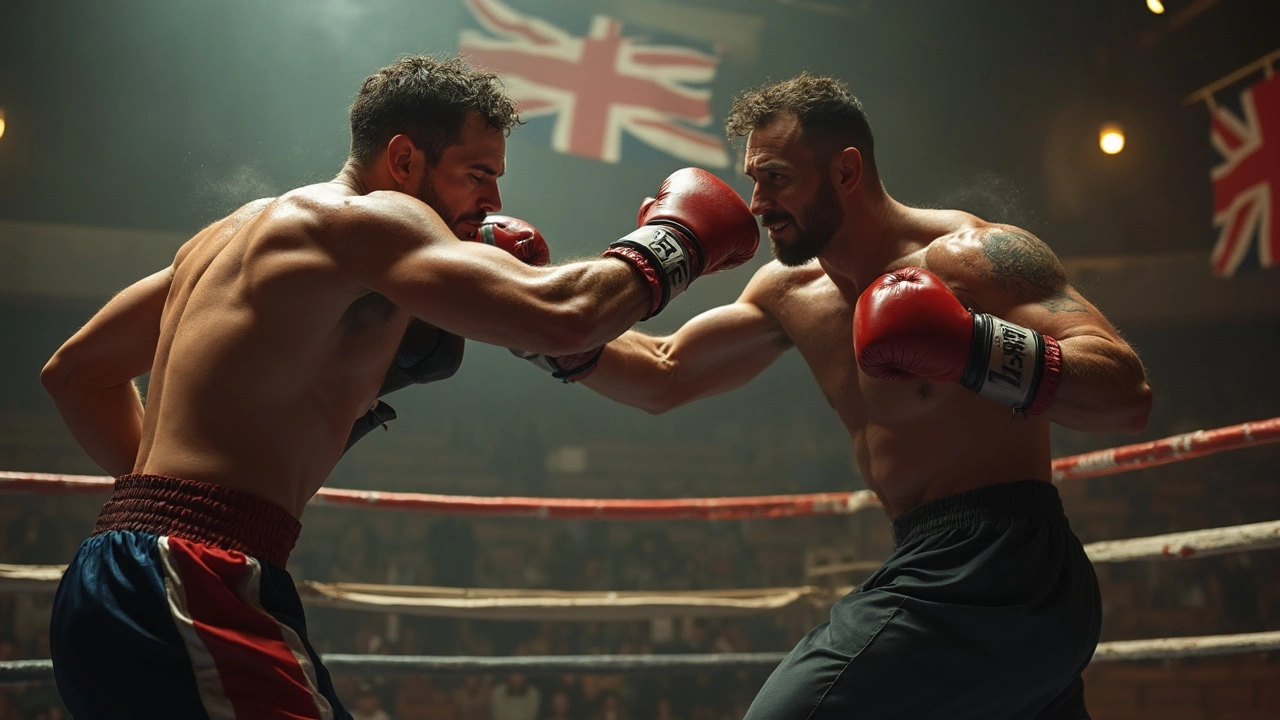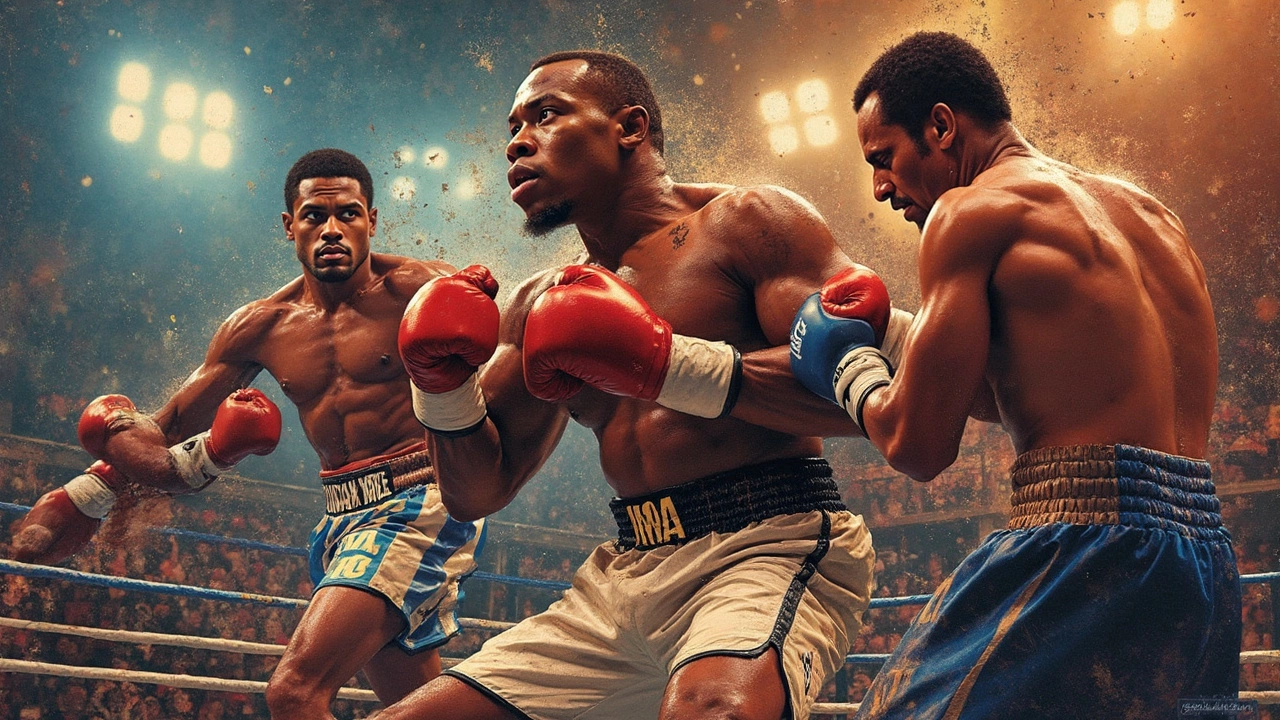Most Aggressive Boxing Style: What Really Dominates the Ring?

You’ve probably watched a match where one fighter just never lets up—charging forward, cutting off the ring, and throwing punches in bunches. That’s not just tough-guy bravado; it’s a full-blown strategy called the swarmer—or sometimes the pressure fighter. Out of all boxing styles, this one is hands down the most aggressive. If you crave action, this is the style to watch.
The beauty of the swarmer style is its simplicity. The goal? Get in your opponent’s face, stay there, and don’t give them a second to breathe. Forget about dancing around—swarmers want to overwhelm with volume. Think Mike Tyson in his early days: non-stop offense, cutting the distance, and blasting away at their opponent’s body and head. Pressure fighters force their rivals to fight at a pace they hate, breaking them physically and mentally.
- Defining Aggression in Boxing
- The Swarmer: King of Aggressive Styles
- Famous Aggressive Fighters
- Advantages, Risks, and Tips for Pressure Fighting
Defining Aggression in Boxing
When folks talk about aggression in boxing, they're not just talking about who throws the hardest punch. Real aggression is about who controls the action, who’s pushing the pace, and who’s making their opponent react. The idea is simple: the more pressure you put on someone, the more likely they are to break, both physically and mentally.
Aggression in boxing usually gets measured by punch output and forward movement. Fighters who throw more punches and fight on the front foot tend to be seen as more aggressive. But it’s not just swinging wildly; it’s all about being effective, picking shots when you’re right in your opponent’s space.
- Punches thrown per round: Top pressure fighters like Manny Pacquiao or Mike Tyson often threw 60-80 punches a round, compared to a more technical, defensive style that might only throw 30-40.
- Ring generalship: Aggressors cut off escape routes, pin opponents on the ropes, and rarely take a backward step.
- Mental pressure: Besides wearing down the body, non-stop aggression wears down the confidence of opponents.
You’ll notice that aggressive bouts usually have higher punch stats. Check out some numbers:
| Fighter | Punches Thrown Per Round | Style |
|---|---|---|
| Mike Tyson | ~60 | aggressive boxing style (Swarmer) |
| Julio Cesar Chavez | ~70 | Pressure Fighter |
| Floyd Mayweather Jr. | ~35 | Defensive/Out-boxer |
That difference matters. It changes not just the look of a fight, but also the strategy. Aggressive fighters always try to take charge, never giving opponents time to reset or get comfortable. If you’re watching and see a guy always pressing forward, crowding the action, you’re seeing true aggression at work.
The Swarmer: King of Aggressive Styles
If you want to see what relentless looks like in boxing, look no further than the swarmer. This isn’t a dance-around-and-jab type of tactic. A swarmer’s whole mission is to close the distance, get up close, and basically smother their opponent with nonstop pressure. The most important aggressive boxing style by far, swarmers are all about intensity and speed.
Classic swarmers like Joe Frazier, Henry Armstrong, and Mike Tyson made their names with this exact approach. Frazier’s win over Muhammad Ali in their first fight? All about cutting off the ring and making Ali fight his pace. Armstrong’s wild punch output? It literally forced rule changes in some matches to stop total punch fests. And Tyson—the way he charged opponents in the first round—made defenders panic and lose their composure.
This style comes with a few defining moves:
- Constant forward movement (almost no backward steps)
- Heavy use of hooks and uppercuts on the inside
- High punch volume—expect to throw over 70 punches a round
- Relentless body shots to take away the other fighter’s energy
- Fast head movement to slip counters and avoid getting tagged clean
If you need numbers, it’s wild: In a legendary 1938 bout, Henry Armstrong threw over 1,200 punches in 15 rounds—that’s more than 80 shots a round. Swarmer stats usually blow defensive fighters out of the water with action. Here’s a quick look at some famous aggressive fighters and their punch output in big bouts:
| Fighter | Punches Thrown (vs. notable opponent) |
|---|---|
| Henry Armstrong | 1,200 (Barney Ross, 1938) |
| Joe Frazier | 430 (Ali, "Fight of the Century") |
| Mike Tyson | 229 in 5 rounds (Trevor Berbick, 1986) |
Pressure isn’t just for show—it actually breaks opponents down. Swarmers are famous for forcing stoppages, either from exhaustion or by overwhelming someone so badly they can’t answer back. But it comes at a cost: swarmers trade safety for control, eating more punches and risking burnout if they don’t get the job done fast. The best swarmers are in amazing shape, have tough chins, and love a scrap.

Famous Aggressive Fighters
When you talk about the most aggressive boxing style, some names pop up right away. These fighters built their careers (and fan bases) on never giving their opponents a break. They made the aggressive boxing style famous around the world.
Mike Tyson is probably the first guy who comes to mind. He was scary fast, compact, and always on the attack. Tyson’s style was all about swarming his opponents early: out of his first 19 wins, 12 were in the first round! He held the record for youngest heavyweight champ at just 20 years old.
Next is Julio César Chávez. He fought way over 100 pro fights and just kept coming forward. Chávez loved pressure fighting. He wasn’t the flashiest, but you could count on him to wear people down, especially to the body.
Joe Frazier is another pressure legend. His famous left hook helped him beat Muhammad Ali in 1971’s “Fight of the Century.” Frazier was relentless—his head movement got him inside, and he just hammered away.
Henry Armstrong took aggressive fighting to another level. Armstrong held three world titles at different weights—all at the same time—and fought more than 170 times. He never stopped coming forward, averaging over 100 punches a round in some fights.
| Fighter | Pro Fights | Knockout % | Career Span |
|---|---|---|---|
| Mike Tyson | 58 | 75.86% | 1985-2005 |
| Julio César Chávez | 115 | 67.82% | 1980-2005 |
| Joe Frazier | 37 | 73.53% | 1965-1981 |
| Henry Armstrong | 181 | 70.17% | 1931-1945 |
If you watch clips of these fighters, you’ll see constant pressure. Their goal was to make it as uncomfortable as possible for their opponents. That’s the real secret behind aggressive boxing—mentally breaking someone before the final bell.
Advantages, Risks, and Tips for Pressure Fighting
No style gets fans yelling louder than an all-out pressure fighter. Let's break down why some choose this path, the setbacks they’ll face, and how you can pull it off without burning out.
Advantages are hard to ignore, starting with control. Pressure fighters usually dictate the pace, making opponents react, not act. This non-stop pace often forces defensive mistakes and builds up points in the judges’ eyes. The relentless style wears opponents down fast—body blows, clinches, and constant movement sap their energy over a few rounds. Mike Tyson’s record backs this up: 26 of his first 28 wins came by knockout, most inside the first three rounds.
| Advantage | Real Example or Stat |
|---|---|
| High Knockout Rate | Mike Tyson: 88% KO ratio in first 28 fights |
| Point Accumulation | Julio César Chávez: 107 wins, most by outworking opponents |
| Opponent Fatigue | Pressure fighters win more late-round stoppages when rivals gas out |
But the risks? They’re just as real. This style means you’re often in the "danger zone," eating counterpunches. Getting hit a lot isn’t just about pain—long-term brain health is a legit concern. Also, fighting at a breakneck pace is brutal on the lungs. Most pressure fighters have to train for 15 rounds even if they’re only fighting 12, because they burn so much energy.
- Higher risk of taking hard counters and clean shots
- Faster fatigue if conditioning slips even a little
- Shorter fighting careers—pressure built stars like Ricky Hatton and Henry Armstrong, but both wore down fast after title runs
Thinking about trying the aggressive boxing style? Here are some basics that every pressure fighter should live by:
- Get comfortable inside—work on bobbing, weaving, and rolling under punches in tight spaces.
- Build cardio for days. Running, sprints, HIIT—don’t skip your roadwork.
- Practice cutting off the ring, not just chasing. You want to trap, not follow.
- Mix up body and head shots to break opponents’ rhythm (watch Roberto Durán for this if you want a clinic in variety).
- Drill explosive combos in short bursts—think "3-3-3" drills (three punch combos, three times, flat out). Simulate fight pressure every session.
Last tip: Learn to take a punch mentally and physically. Almost every classic swarmer could get hit and keep coming. If you’re planning to dominate with this style, grit might matter as much as skill.
